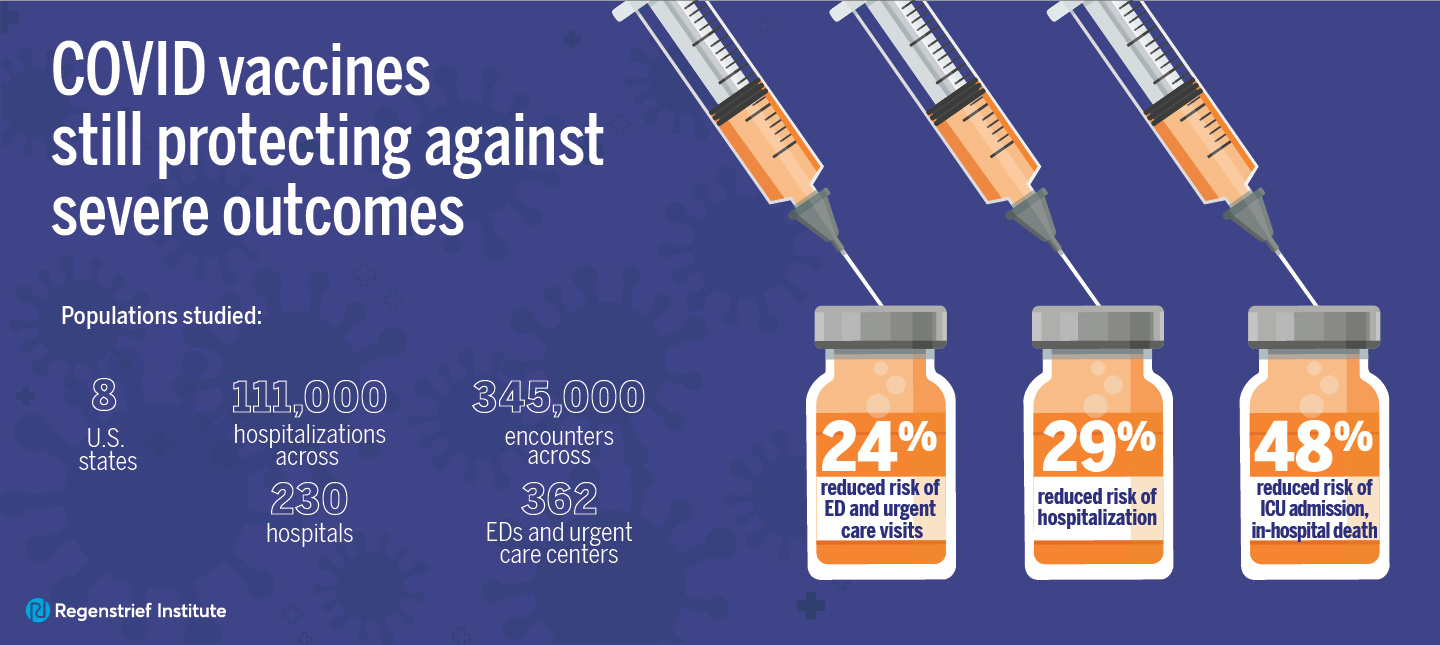Study also finds less severe disease during BA.4/BA.5 predominance compared to earlier Omicron variants
A multi-state study from the U.S. Centers for Disease Control and Prevention’s (CDC) VISION Network has found that first-generation COVID-19 mRNA vaccines were associated with protection against COVID-19 during periods of Omicron BA.4/BA.5 predominance.
The new analysis found that mRNA vaccines were protective against COVID-19-associated hospitalization and ICU admission or in-hospital death and noted less severe disease during BA.4/BA.5 predominance compared to earlier Omicron variants.
During BA.4/BA.5 predominance, estimated 3-dose vaccine effectiveness against hospitalization was 68 percent between 7- and 119-days post-vaccination. Vaccine effectiveness against hospitalization decreased to 36 percent by 120 days or more post-vaccination.
For hospitalization, an indicator of severe disease, estimated vaccine effectiveness of three doses for all adults and four doses for adults aged 50 or older was similar to that reported during predominance of earlier Omicron variants. However, hospitalized adults were less likely to be admitted to the ICU or experience in-hospital death and had shorter length of stay during BA.4/BA.5 predominance compared to earlier Omicron variants.
“Our findings that COVID-19 mRNA vaccines remain effective and that vaccinated adults weren’t as sick during BA.4/BA.5 predominance is encouraging as we look ahead to development of future vaccines and strategies for combatting the virus,” said study co-author Shaun Grannis, M.D., M.S., Regenstrief Institute vice president for data and analytics.
“Estimation of COVID-19 mRNA Vaccine Effectiveness and COVID-19 Illness and Severity by Vaccination Status During Omicron BA.4 and BA.5 Sublineage Periods,” is published in JAMA Network Open.
The study authors note that COVID-19 vaccine effectiveness estimation “has become complex as additional vaccine booster doses are authorized, vaccine-induced protection wanes over time, new variants or subvariants have emerged, and a majority of the US population has experienced previous infection (57-94%, depending on source).”
“As new variants emerge, ongoing monitoring of vaccine effectiveness is critical for informing public health strategies and treatment of patients,” said study co-author Brian Dixon, PhD., MPA, interim director of Regenstrief Institute’s Center for Biomedical Informatics. “Tracking performance of vaccines will also help develop better vaccines and inform best practices for future pandemics.”
This new study analyzed 82,229 emergency department or urgent care encounters and 21,007 hospitalizations for COVID-19-like illness in adults ages 18 and older. Nine VISION sites in 10 states contributed data including 268 hospitals, 292 emergency departments and 140 urgent care clinics.
The authors write, “Estimated vaccine was similar across outcomes, contradicting many past vaccine effectiveness studies, including previous studies from VISION, which have tended to show higher vaccine-associated protection for more severe outcomes. This could be due to changes in baseline population immunity (e.g., most adults now have evidence of prior infection), changes in behavior (e.g., decreased use of social distancing and masks during recent months), or residual confounding.”
Regenstrief Institute authors of this VISION Network study, in addition to Drs. Grannis and Dixon, are William F. Fadel, PhD; Nimish Ramesh Valvi, DrPH, MBBS; and former Institute president and current affiliate scientist Peter EmbÍ, M.D.
Authors and affiliations
Ruth Link-Gelles, PhD, MPH1; Matthew E. Levy, PhD2; Karthik Natarajan, PhD3,4; Sarah E. Reese, PhD2; Allison L. Naleway, PhD5; Shaun J. Grannis, M.D., MS6,18; Nicola P. Klein, M.D., PhD8; Malini B. DeSilva, M.D., MPH9; Toan C. Ong, PhD10; Manjusha Gaglani, MBBS11,12; Emily Hartmann, MPP13; Monica Dickerson, B.S.1; Edward Stenehjem, M.D., MSc14; Anupam B. Kharbanda, M.D.15; Jungmi Han, B.S.3; Talia L. Spark, PhD2; Stephanie A. Irving, MHS5; Brian E. Dixon, PhD, MPA6,7; Ousseny Zerbo, PhD8; Charlene E. McEvoy, M.D., MPH9; Suchitra Rao, MBBS, MSCS10; Chandni Raiyani, BDS, MPH11; Chantel Sloan-Aagard, PhD13,16; Palak Patel, MBBS, MPH1; Kristin Dascomb, M.D., PhD14; Anne-Catrin Uhlemann, M.D., PhD17; Margaret M. Dunne, MSc2; William F. Fadel, PhD6,7; Ned Lewis, MPH8; Michelle A. Barron, M.D.10; Kempapura Murthy, MBBS, MPH11; Juan Nanez, R.N., BSN13; Eric P. Griggs, MPH1; Nancy Grisel, MPP14; Medini K. Annavajhala, PhD17; Akintunde Akinseye, MSPH2; Nimish R. Valvi, DrPH6; Kristin Goddard, MPH8; Mufaddal Mamawala, MBBS, MPH11; Julie Arndorfer, MPH14; Duck-Hye Yang, PhD2; Peter J. Embí, M.D., MSc6,18,19; Bruce Fireman, MA8; Sarah W. Ball, ScD, MPH2; Mark W. Tenforde, M.D., PhD1.
1Centers for Disease Control and Prevention COVID-19 Response Team, Atlanta, Georgia; 2Westat, Rockville, Maryland; 3Department of Biomedical Informatics, Columbia University Irving Medical Center, New York, New York; 4New York-Presbyterian Hospital, New York; 5Center for Health Research, Kaiser Permanente Northwest, Portland, Oregon; 6Center for Biomedical Informatics, Regenstrief Institute, Indianapolis, Indiana; 7Fairbanks School of Public Health, Indiana University, Indianapolis; 8Kaiser Permanente Vaccine Study Center, Kaiser Permanente Northern California Division of Research, Oakland; 9HealthPartners Institute, Minneapolis, Minnesota; 10School of Medicine, University of Colorado Anschutz Medical Campus, Aurora; 11Baylor Scott & White Health Temple, Texas; 12Texas A&M University College of Medicine, Temple; 13Paso del Norte Health Information Exchange (PHIX), El Paso, Texas; 14Division of Infectious Diseases and Clinical Epidemiology, Intermountain Healthcare, Salt Lake City, Utah; 15Children’s Minnesota, Minneapolis, Minnesota; 16Brigham Young University Department of Public Health, Provo, Utah; 17Department of Internal Medicine, Division of Infectious Disease, Columbia University Irving Medical Center, New York, New York, United States; 18School of Medicine, Indiana University, Indianapolis, Indiana; 19Vanderbilt University Medical Center, Nashville, Tennessee.
About Shaun Grannis, M.D., M.S.
In addition to his role as the vice president for data and analytics at Regenstrief Institute, Shaun Grannis, M.D., M.S., is the Regenstrief Professor of Medical Informatics and a professor of family medicine at Indiana University School of Medicine
About Brian E. Dixon, PhD, MPA
In addition to his roles as interim director of the Regenstrief Institute’s Clem McDonald Center for Biomedical Informatics and director of public health informatics for Regenstrief Institute and Indiana University Richard M. Fairbanks School of Public Health, Brian E. Dixon, PhD, MPA is a professor of epidemiology at the Fairbanks School of Public Health. He is also an affiliate scientist at the U.S. Department of Veterans Affairs Health Services Research and Development Center for Health Information and Communication, Richard L. Roudebush VA Medical Center.
About Regenstrief Institute
Founded in 1969 in Indianapolis, the Regenstrief Institute is a local, national and global leader dedicated to a world where better information empowers people to end disease and realize true health. A key research partner to Indiana University, Regenstrief and its research scientists are responsible for a growing number of major healthcare innovations and studies. Examples range from the development of global health information technology standards that enable the use and interoperability of electronic health records to improving patient-physician communications, to creating models of care that inform practice and improve the lives of patients around the globe.
Sam Regenstrief, a nationally successful entrepreneur from Connersville, Indiana, founded the institute with the goal of making healthcare more efficient and accessible for everyone. His vision continues to guide the institute’s research mission.
About IU School of Medicine
IU School of Medicine is the largest medical school in the U.S. and is annually ranked among the top medical schools in the nation by U.S. News & World Report. The school offers high-quality medical education, access to leading medical research and rich campus life in nine Indiana cities, including rural and urban locations consistently recognized for livability.
About the Richard M. Fairbanks School of Public Health
Located on the IUPUI and Fort Wayne campuses, the Richard M. Fairbanks School of Public Health is committed to advancing the public’s health and well-being through education, innovation and leadership. The Fairbanks School of Public Health is known for its expertise in biostatistics, epidemiology, cancer research, community health, environmental public health, global health, health policy and health services administration.








